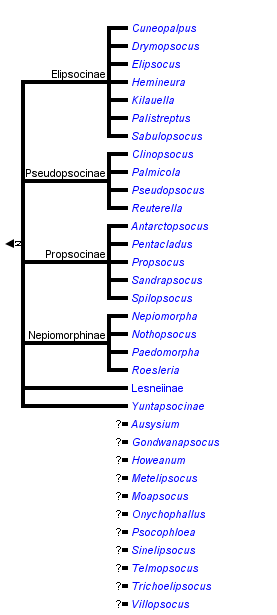Elipsocidae
Emilie Bess and Kevin P. Johnson


This tree diagram shows the relationships between several groups of organisms.
The root of the current tree connects the organisms featured in this tree to their containing group and the rest of the Tree of Life. The basal branching point in the tree represents the ancestor of the other groups in the tree. This ancestor diversified over time into several descendent subgroups, which are represented as internal nodes and terminal taxa to the right.

You can click on the root to travel down the Tree of Life all the way to the root of all Life, and you can click on the names of descendent subgroups to travel up the Tree of Life all the way to individual species.
For more information on ToL tree formatting, please see Interpreting the Tree or Classification. To learn more about phylogenetic trees, please visit our Phylogenetic Biology pages.
close boxIntroduction
The family Elipsocidae contains about 130 species in 33 genera distributed worldwide. Nine species are known from North America in the genera Elipsocus, Cuneopalpus, Reuterella, Propsocus, and Nepiomorpha. Two genera of Elipsocidae, Kilauella and Palistreptus, have diversified on the Hawaiian Islands and may include dozens of additional species that are yet undescribed.
These are small to medium-sized bark lice (1-4.5 mm, nymphs 1-3 mm) with robust bodies. Body colors are brown or blackish. Elipsocids inhabit bark, stone surfaces, dead leaves, and leaf litter. Some species are sexually dimorphic (different body forms in male and female) or polymorphic (different body forms within a sex).
Characteristics
Synapomorphies:
The epistomal suture of the head has a broad internal ridge.
Hindwing marginal hairs are restricted between veins R2,3 and R4,5.
Tarsi have 3 segments in many species.
General characters:
- Head: Antennae have 13 segments (occasionally fewer).
- Legs: Tarsi have 3 segments in most species, occasionally 2 segments.
- Wings:
- Forewing veins similar to "Caecillius" pattern:
- Areola postica is sometimes absent,
- when present it is usually free of vein M, but sometimes joined to vein M.
- Forewing hairs:
- Either dense or sparse.
- Often in more than one row on main veins, single row on branches.
- Hairs on wing margin do not cross each other.
- Hindwing surface is hairless.
- Hindwing hairs on margin are restricted between veins R2,3 and R4,5.
- Male:
- Phallosome is closed and pointed with external parameres about 1/3 length of phallosome.
- Phallosome tip has strong sclerification.
- Females:
- Subgenital plate has one or two lobes.
- Gonapophyses are usually compete:
- Ventral valve is pointed, preapical lobe may be present.
- Dorsal valve is pointed, preapical lobe may be present.
- External valve is large and hairy.
- Eggs: Eggs are laid in groups and covered with encrustation.
How to Know the Family
- Antennae have 13 segments (occasionally fewer).
- Legs: Tarsi have 3 segments in most species, occasionally 2 segments.
- Forewing:
- Areola postica is sometimes absent.
- Hairs on wing margin do not cross each other.
- Hindwing: Hairs on margin are restricted between R2,3 and R4,5.
Family Monophyly
Recent morphological analysis suggests that the monophyly of Elipsocidae is uncertain. The classification used here is based on the catalog by Leinhard and Smithers (2002) and supported by morphological analysis by Yoshizawa (2002). Morphological characters supporting monophyly include: the epistomal suture of the head has a broad internal ridge, the hindwing marginal hairs are restricted between veins R2+3 and R4+5, and many species have three-segmented tarsi (Yoshizawa 2002). Schimdt and New (2004), however, suggested that four genera should be excluded from the family based on morphological data: Palmicola moved to Mesoposcidae, Sabulopsocus and Moapsocus moved to Sabulopsocidae (a new family), and Drymopsocus incertae sedis.
Discussion of Phylogenetic Relationships
In molecular analysis of nuclear gene 18S, two species of Elipsocidae (Nepiomorpha sp. and Kilauella sp.) were found to be sister to each other (Johnson et al. 2004), but relationships within the family have not been investigated further with molecular data. Additional work is needed to clarify the relationships within Elipsocidae.
References
Johnson, K. P. & E. L. Mockford. 2003. Molecular Systematics of Psocomorpha (Psocoptera). Systematic Entomology 28: 409-40.
Johnson, K. P., K. Yoshizawa, and V. S. Smith. 2004. Multiple origins of parasitism in lice. Proceedings of the Royal Society of London B 271:1771-1776.
Lienhard, C. and C. N Smithers. 2002. Psocoptera (Insecta) World Catalogue and Bibliography. Muséum d'Histoire Naturelle, Geneva, Switzerland.
Mockford, E. L. 1993. North American Psocoptera (Insecta). Gainesville, Florida: Sandhill Crane Press,
New, T.R. 2005. Psocids, Psocoptera (Booklice and barklice), 2nd edition: Handbooks for the Identification of British Insects. Vol. 1, Part 7. Royal Entomological Society, London, UK.
Schmidt, E.R. and T. R. New. 2004. A systematic and phylogenetic revision of the family Elipsocidae (Insecta : Psocoptera), with the erection of two new families: Lesneiidae and Sabulopsocidae. Invertebrate Systematics 18: 157 – 213.
Smithers, C. N. 1996. Psocoptera. Pp. 1-80, 363-372 (Index) in Wells A. (ed.) Zoological Catalogue of Australia. Vol. 26. Psocoptera, Phthiraptera, Thysanoptera. Melbourne: CSIRO Publishing, Australia.
Yoshizawa, K. 2002. Phylogeny and higher classification of suborder Psocomorpha (Insecta: Psocodea:'Psocoptera'). Zoological Journal of the Linnean Society 136: 371-400.
About This Page
Emilie Bess

Illinois Natural History Survey, Champaign, Illinois, USA
Kevin P. Johnson

Illinois Natural History Survey, Champaign, Illinois, USA
Correspondence regarding this page should be directed to Emilie Bess at and Kevin P. Johnson at
Page copyright © 2009 Emilie Bess and Kevin P. Johnson
All Rights Reserved.
- First online 25 March 2009
- Content changed 25 March 2009
Citing this page:
Bess, Emilie and Kevin P. Johnson. 2009. Elipsocidae. Version 25 March 2009 (under construction). http://tolweb.org/Elipsocidae/30252/2009.03.25 in The Tree of Life Web Project, http://tolweb.org/





 Go to quick links
Go to quick search
Go to navigation for this section of the ToL site
Go to detailed links for the ToL site
Go to quick links
Go to quick search
Go to navigation for this section of the ToL site
Go to detailed links for the ToL site